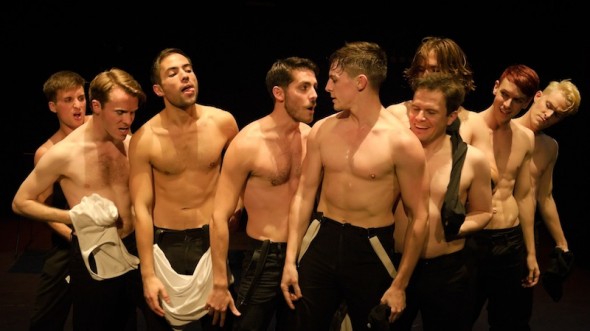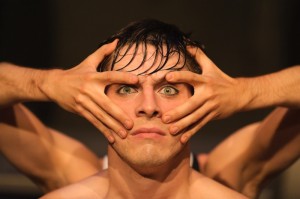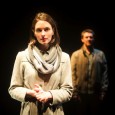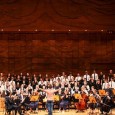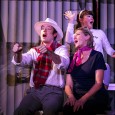I was very curious about how the extreme violence of A Clockwork Orange, the Anthony Burgess literary classic and the 1971 Stanley Kubrick film, would work on stage.
But the Action to the Word Les Currie production, directed by Alexandra Spencer-Jones, manages to convey the testosterone-fuelled adolescent violence that made both the novella and the film cult hits and the declared forerunners of the punk movement.
And it does this without resorting to visually graphic violence that merely aims to shock.
This stunning production is a ferocious but finely choreographed adaptation of the rise and fall of Alex De Large, played superbly by Martin McCreadie.
It relies on the familiarity of the original, the beauty and seduction of the music and the virile aggression of its physical theatre to tell its tale of adolescent violence and governmental retribution.
The all-male ensemble struts, crawls and minces its way through 90 action-packed minutes, conveying the effervescent vitality of youth, the frustration and disappointment of poverty and the thrust for power and sexual dominance.
This is the world of Alex and his Droogs.
They speak in the Nadsat slang, a futuristic Anglo-Russian concoction of colloquialisms that Burgess created based on the street slang of the time among the Teddy boys, the Mods and Rockers. At times this language is hard to follow so if you get the chance, glance over the Nadsat dictionary thoughtfully provided at the theatre.
The plot follows Alex and his obsession with violence, which eventually sees him sent to prison for rape and murder. Keen to be free Alex agrees to be a guinea pig in the Ludovico experiment that claims to convert criminals in two weeks through drastic psychological conditioning.
But he gets more than he bargained for, so traumatised by a side effect of the treatment that leaves him unable to hear classical music, including his much-loved Beethoven, that he attempts suicide. His reaction is used as a weapon against government conditioning and the treatment is reversed so he regains both his previous love of violence and of music.
Visually the production is stark: startling black and white costumes, with the occasional flash of Guantanamo Bay orange that represents the state, and a bare stage, furnished only with a table and chairs.
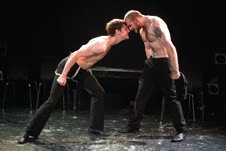 This is physical theatre, the meaning conveyed less by a tightly controlled script and more by the movement, music and magic on stage.
This is physical theatre, the meaning conveyed less by a tightly controlled script and more by the movement, music and magic on stage.
This approach works, delivering a production that is violent and highly erotic, overtly sexual and tauntingly homoerotic.
But the violence is abstract, conveyed by the power of dance and music; its soundtrack bypasses the song list Burgess outlined and instead supplements the music of Beethoven with music from the 1960s to the present, including David Bowie, Gossip, Scissor Sisters, Placebo, Frankie Goes to Hollywood and Pink Floyd.
The homoerotic element is at times heavy-handed, made more blatant by the fact that the entire 10-member ensemble is male so that men play women’s roles in the Shakespearean tradition. Director Spencer-Jones denies the work is either gay or straight but says she used sexuality in all its forms as another symbol and weapon of power.
 She first became interested in exploring “what it is to be a boy – and really, what it is to be a bad boy” when working on a production of Romeo & Juliet in 2009 and realised Romeo was as much a Montague fighter as he was a lover.
She first became interested in exploring “what it is to be a boy – and really, what it is to be a bad boy” when working on a production of Romeo & Juliet in 2009 and realised Romeo was as much a Montague fighter as he was a lover.
It is interesting that this production includes the final chapter of the Burgess novel (omitted in the Kubrick 1971 film) where Alex turns his back on the violence of his teen years to take on the responsibilities of adulthood – 21 chapters, with the last signifying the coming of age.
That inclusion brings it closer to the Burgess vision and his urge to explore the ethical question of whether being good has any value if it is not the result of a conscious choice, what Burgess has called “an allegory of free will”.
As Burgess wrote in 1986, aggression is a misdirected creative force that is outgrown in maturity so even thugs can be redeemed – in time. Much more dangerous is the loss of free choice.
That is the ultimate message of this interesting and entertaining production which sold out its season in London’s West End and is now touring Australia.
A Clockwork Orange is at the York Theatre at Sydney’s Seymour Centre until May 5. Tickets: (02) 9351 7940 or Ticketmaster 136 100.
Perth’s Subiaco Arts Centre from May 7-19. Book at ticketek.com.au or Ticketek 1300 795 012.
Canberra: The Playhouse, Canberra Theatre Centre from May 22-25. Book on (02) 6275 2700.
Brisbane: QPAC Cremorne Theatre from May 28 to June 9. Book on 136 246.

